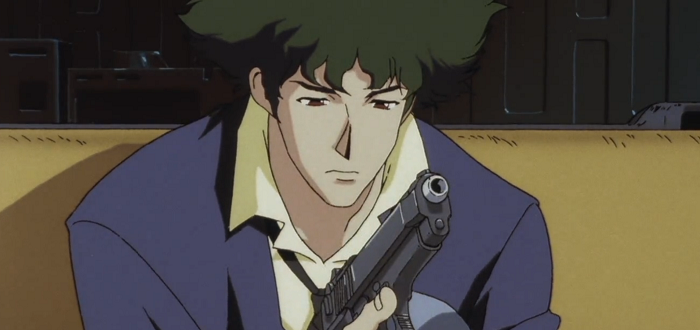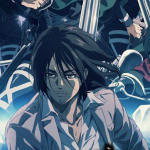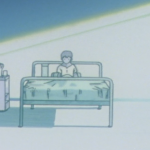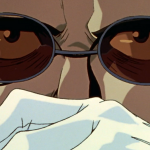Adios, Cowboy: Review 5 – Ballad of the Fallen Angel
For real, Cowboy Bebop, I don’t understand you at all.
After four episodes of parallel but opposite plot structure, Ballad of the Fallen Angel throws out the established playbook and pivots hard toward a conventional revenge story. Spike’s personal history leads to his setting aside the mantle of bounty hunter amid a somber quest for Pyrrhic revenge. This is, at once, an exemplar of how to do symbolism in a visual medium, a powerful payday on past episodes hinting toward a bigger story, an unfortunate commitment to anime fan service, and maybe the best episode of the show since Asteroid Blues. It is, at once, infuriating and amazing.
Bearing the above in mind, I want to approach this powerful episode through an examination of what I can only presume is another manifesto from Keiko Nobumoto and Shinichirō Watanabe. The audience sees the following text in the bumpers between the episode’s first and second act…
Of course this is not a war film, as either princess nor army, whom you often find in science fiction films, appear on stage. This is not a kind of Space Opera. It is a kind of Space Jazz, which is filled with street sense and life. That is why the central figure’s occupation is not a hero nor a soldier but a bounty hunter.
Allow me to respond to this manifesto with a bon mot of my own: la mort de l’auteur. The above manifesto may be Nobumoto and Shinichirō’s goal, but it is not coming through in this episode. In point of fact, I think this episode demonstrates the antithesis of the series/episode’s ostensible mission statement.
Let’s begin deconstructing the bumper text through an examination of the claim that there are no armies in this show. Granted, there are no analogues to the United States Colonial Marines in the show, but the moods and motifs of Bebop reflect a clear difference between people who fight and those who live in spite of the former.
Consider how each episode to this point has focused on Spike dealing with the likes of criminal syndicate mercenaries, fully militarized terrorist groups, or the heavy fist of law enforcement. Bebop might divest itself of the obvious binaries – like using blaster bolts to indicate the good guys from bad guys – but there are still armies in so much as the series alludes to a future of corporate tribalism replacing nation state-level strife. At the very least, Blade Runner’s social split of “police” and “little people” seems entirely applicable to Cowboy Bebop.
Next, we can engage with the idea of Cowboy Bebop as a series that offers no princesses. This is technically correct – the most obnoxious kind of correct. In the context of Bebop being a form of rebellion against the norms of space opera as enshrined in Star Wars, Bebop is absent princesses. Then again, princesses in Star Wars tend to be both competent fighters and skilled leaders. What Bebop offers is something much worse than the 70s/80s cinematic princess. Faye, who over the course of her three episodes has managed to get handcuffed in increasingly festish-tastic poses, is a princess of the Edgar Rice Burroughs vintage: a low-rent Dejah Thoris. She exists to stimulate the fantasies of teenage boys as an antecedent to being kidnapped to stir the main character to action. Given her place of birth, Faye is, quite literally, a princess of Mars.
Also, these are the last words I want to dedicate to Faye on this point. Unless something particularly dramatic happens with her character, I am done banging this particular drum. There are more interesting things to do with this show than prattle on about how anime fan service hasn’t changed in the last 20 years.
Which brings us to the idea of Cowboy Bebop being “Space Jazz.” If we roll back to episode 1, I would not contest this point. By episode 5, the only way Bebop is Space Jazz if Martin Scorsese is conducting the band. Ballad’s catalyst is a man called Vicious. Physically, he is the love child of Sephiroth and Captain Harlock (complete with weird space bird on his shoulder). As an introduction, he sabotages a peace treaty between two formerly warring syndicates. The leader of one such syndicate, Mao Yenrai, happens to be Spike’s father (figure). The doomed man’s final words are to say, “If only Spike returned.”
And return he does.
Spike’s return to the old life – just when he thought he was out – adds more depth to his and Jet’s character than is seen in all previous episodes combined. In a callback to a narrative manifesto about breaking traditional styles, this episode abandons Bebop’s story-focused style for an intense character study. Both Spike and Jet know that the bounty on Spike’s father (figure) is a set-up. Where Jet wants nothing to do with it, a combination of loyalty and honour drives Spike toward a place that invokes the shootout in the cold open of the first episode.
At this point, one can go deep into symbolism within this episode. The opening and closing moments show Spike drawing/receiving an ace of spades from a deck of cards. In this moment, the significance of the ace is two-fold: it is at once the strongest card in the deck, like Spike, and a portent of death, like Spike, as made infamous by American GIs in Vietnam. Furthermore, and according to something called “cardomancy,” which I only invoke given Cowboy Bebop’s compulsion toward using mysticism and augury to move the plot, the ace of spades represents transformation.
The latter might seem like a trifle of mystic woo-woo nonsense, but literal transformation is a motif within his show. Both Abdul Hakim and Morgan transformed their faces in an attempt to hide from police and bounty hunters. During a conversation with a shopkeeper called Ana, who knew Spike from his old days as a hired killer, the camera twice cuts to a picture of Mao Yenrai, a younger Ana, and someone unknown to the audience. Is it a person yet to be discovered, or is it a younger version of Spike before he changed his face into the version familiar to the audience? Consider that during the battle between Vicious and Spike, the former asks Spike, “do you know what your face looks like right now?”
Regardless of if I’m right in my interpretations, the episode is so intentionally rich in its symbolism, and so pointed in how it repeatedly shows its symbols, that it is inviting the audience build this depth of engagement. Consider as well that the episode opens with Mao Yenrai sealing a contract in blood and it ends with Vicious telling Spike that, “the same blood runs in you and me.” While the line alone is simply a metaphor, the line paired with the imagery of a father (figure) sealing a contract in blood hints toward the much deeper bond.
And amid these symbols for death and transformation, we cut back to Jet trimming too much from his Bonsai Tree. As the irreplaceable branch falls from the plant, Jet recognizes his indifference toward the episode’s conflict as something that would lead to, symbolically, another of his limbs forever severed. Thus, the man who lost an arm from recklessly charging into battle, as told to Spike as an effort to keep him from rushing headlong to his death, takes off to support his bounty hunting partner. Remind me again why I should ignore all this symbolism to see Bebop as something about characters with street sense instead of taking in this episode as a war story by another name?
How is Spike is not at war with his past to forge some sort of future? How are Spike and Jet any different than Han and Luke as comrades-in-arms fighting to, in the style of the opening credits, “create a new dream”? To borrow a line from the Seatbelts’ Rain – the majestic and haunting song that punctuates Spike’s journey to his battle with Vicious – “If there is a hell, I’m sure this is how it smells.” This episode walks like a war story, talks like a war story, and smells like a war story; to borrow another phrase, this time from General William Sherman, “war is hell.” Thus do I submit, this is a war story.
With all due deference to the authors, the story you told is not the story you intended. This is the best episode of Cowboy Bebop to date, and it is decidedly not Kung Fu Jazz, Space Jazz, or any other kind of Jazz. The only way this episode would have been more traditional is if Spike were played by Charles Bronson. While it is well and good to talk about applying narrative jazz to a story, Ballad of the Fallen Angel clearly shows that plot jazz bends the knee before the likes of Death Wish.













